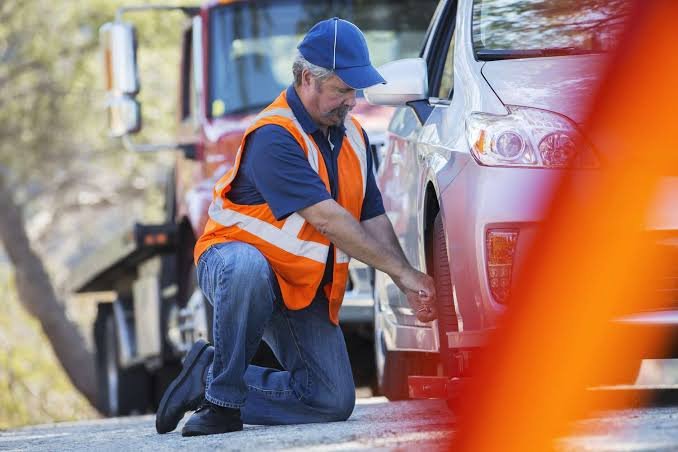Business
What Are The DVLA Rules For Registering 4D Plates In The UK?

In the UK, car registration plates were not only necessary for identifying an automobile but also provided car owners a way to express themselves and personalize their vehicles. Of all the possibilities accessible, 4D plates have become more and more well-liked due to their distinctive style and visual attractiveness. However, there are some guidelines and procedures that must be followed to register 4D plates UK through the Driver as well as Vehicle Licensing Agency (DVLA). The goal of this post is to offer a thorough how-to for DVLA registration requirements for 4D plate holders in the UK. If you are looking forward to installing a license plate search for 4B Plates UK
Why Do 4d Number Plates Exist?
In the UK, 4D registration numbers are a recent addition. The primary distinction between 3D and 4D number plates that you may have seen previously is that 3D plates are two-toned instead of having elevated characters. As of September 2023, UK number plates will not be able to use these two-tone digits because of the DVLA’s stricter definition of black and the requirement to clearly distinguish between each digit and retro-reflective NIR values. This will help the ANPR cameras detect your registration. This modification results from the adoption of a new British Standard (BS145e), which will go into effect in September 2023.
In The UK, Are 4D Number Plates Legal?
These days, there are so many distinct types that are available for purchase that it can be challenging to determine what is and is not legal. When 4D legal registration numbers satisfy the requirements established by the DVLA, they are in reality legal.
If you’re considering obtaining a 4D license plate, we suggest that you adhere to the requirements established by the DVLA to guarantee that your plate remains road-valid. The following specifications must be met by the license plate you have according to the DVLA:
- A reflective material-covered backing.
- To have distinct black text set against a white or yellow backdrop.
- The required typeface for printing them is the normal Charles Wright style, with letters measuring 50 mm in width, 79 mm in height, and 11 mm between.
- Number plates, including those with trademarked logos, must have a patterned backdrop.
- The producer of the material, the firm name and address of the Registered Number Plate Supplier, the British Standardization number, and the bottom right quadrant must all be present.
Adherence To The Law:
- All automotive license plates, including 4D plates, are subject to DVLA standards that specify the size, typeface, spacing, and format requirements.
- The DVLA has established standard font criteria for 4D plates, which provide uniformity and reading for all registered cars.
- To preserve clarity and readability for agents of law enforcement and automatic recognition systems, the letters and numbers on 4D plates must adhere to precise rules set forth by the DVLA regarding character height and spacing.
Composition And Materials:
- DVLA requirements concerning durability, transparency, and reflectivity must be met for 4D plates to maintain their distinctive design aesthetic.
- Reflective materials on 4D plates enable visibility in a variety of lighting settings, improving road user safety as well as visibility.
- To preserve accessibility and comply with DVLA standards, the embosse lettering on 4D plates must be firmly affix and impermeable to fading, peeling off, going or deteriorating over time.
Legal Symbols And Markings:
- The DVLA mandates that 4D plates bear the necessary legal indications, such as the number of the registration, the manufacturer’s information, and the British Standard (BS AU 145d) mark.
- The DVLA’s guidelines and regulations must be follow by any extra symbols or emblems used on 4D plates to make sure they don’t cover up or make it difficult to read important information.
Manufacturer And Supplier Compliance:
- Automobile owners must make sure the producer and supplier of 4D plates have registered with the appropriate industry bodies and adhere to DVLA requirements before making a purchase.
- Reputable manufacturers of 4D plates ought to offer records attesting to their adherence to legal requirements, production procedures, and materials utilized, as well as their conformity with DVLA standards.
What Factors Led To The Change?
The goal of the most recent production standard for plates, which was implement in 2021, is to guarantee that they maintain their quality even after several decades of exposure to various road conditions and weather. Their purpose is to guarantee that vehicle license plates are observable.
Final Words
To sum up, to register 4D plates through the DVLA in the UK, one must follow certain guidelines about the material, structure, size, font, spacing, as well as display. Although 4D plates provide a distinctive and adjustable choice for car owners looking to customise their rides, adhering to DVLA regulations is crucial to guarantee legality, visibility, safety road safety. Car owners can profit from the unique aesthetics of 4D registrations while still complying with legal obligations and supporting UK highway security initiatives by being aware of and following DVLA registration guidelines. Also read more hinttoday.com interesting articles.
Business
Gaining a Competitive Edge: Leveraging Customer Feedback for Success


What is Customer Feedback?
Customer feedback is information clients provide about their experiences with a company’s products or services. It can take various forms, including surveys, reviews, and direct communication. Leveraging the right customer feedback software can streamline the process, making gathering and analyzing valuable data easier. Feedback allows businesses to understand their clientele’s expectations and perceptions, which is essential for continuous improvement.
Customer feedback aligns with your audience’s opinions, concerns, and suggestions. It enables companies to highlight strengths and identify weaknesses. By routinely gathering and evaluating customer input, businesses may stay competitive and relevant in a rapidly changing market.
Why Customer Feedback Matters
Feedback is crucial because it offers businesses a window into what’s working and what’s not. According to Forbes, happy customers are more likely to return and recommend products to others, directly impacting revenue. Businesses may adjust and advance by knowing the requirements and preferences of their customers, fostering greater customer loyalty and satisfaction. Ignoring customer feedback might result in lost chances for development and ongoing enhancement.
Furthermore, constructive feedback helps identify market trends and consumer behavior. It provides actionable insights that can shape business strategies. By actively seeking and valuing customer feedback, businesses may give their audience more credibility and a closer bond, which will help them feel heard and valued.
Different Methods for Collecting Customer Feedback
Gathering feedback can be done through various methods, including:
- Online surveys
- Social media interactions
- Customer interviews
- Feedback forms on websites or apps
Every approach offers benefits, and the best choice will depend on the company’s demands and clientele. For instance, online surveys are quick and cost-effective, allowing companies to reach a large audience. On the other hand, social media interactions provide real-time feedback and conversationally engage customers. Customer interviews offer in-depth insights that can uncover deeper issues or highlight new opportunities. At the same time, feedback forms on websites or apps provide a structured way for customers to share their thoughts at their convenience.
Analyzing Customer Feedback
Once collected, feedback must be analyzed to spot trends and patterns that help guide strategic choices. Practical analysis can provide insights into areas needing improvement and highlight successful aspects of the business. Utilize data analytics tools to process large volumes of feedback and derive actionable insights. This step is crucial as it translates raw data into meaningful information that can lead to significant improvements.
Analyzing feedback involves looking for recurring themes, categorizing responses, and using metrics to measure overall sentiment. For instance, many complaints about a particular feature indicate a need for improvement. Positive feedback on specific aspects can affirm the effectiveness of current practices and help replicate successes in other areas. Businesses can prioritize actions that yield the most significant impact by systematically analyzing feedback.
Implementing Changes Based on Feedback
More than collecting and analyzing feedback is required, as businesses must act on the insights gained. Putting suggestions into practice can result in enhanced customer satisfaction and loyalty. For example, if multiple customers criticize the same feature, it indicates that improvement is needed. Conversely, positive feedback can help reinforce what’s working well and drive its further development.
Implementing feedback effectively involves setting clear goals, allocating resources, and communicating changes to customers. Customers must feel that their opinions are essential, resulting in real advancements. This can be done through updates on social media, email newsletters, or direct communication. Demonstrating responsiveness to feedback boosts customer satisfaction and encourages more customers to share their opinions.
Common Challenges in Gathering and Using Feedback
Although valuable, gathering and using customer feedback has its challenges. One major issue is potential response bias. Ensuring that feedback is representative and actionable requires thoughtful strategies. Businesses must also address input promptly to keep customers engaged and satisfied. Overcoming these challenges involves using diverse feedback collection methods and ensuring anonymity to encourage honest responses.
Another challenge is the sheer volume of feedback that can be received, making it hard to sift through and find actionable insights. Prioritizing issues based on frequency and impact can help manage this workload. Additionally, continuous monitoring and updating of feedback strategies are essential to remain aligned with evolving customer expectations and technological advancements.
Success Stories: Businesses Thriving from Feedback
Many companies have successfully used customer feedback to grow and improve. For example, XYZ Company redesigned its product features based on user suggestions, resulting in a 20% rise in client retention and a notable boost in customer satisfaction. Such success stories underline the importance of listening to customers and valuing their opinions.
In another case, a small business revamped its customer service protocols after consistently receiving feedback about slow response time. Hiring additional support staff and implementing a more efficient ticketing system cut response times by 50%, resulting in a rise in favorable evaluations and heightened patronage.
Conclusion
Consumer reviews are an effective strategy for expanding a firm. Companies can better meet customer needs, improve products and services, and drive success by collecting, analyzing, and implementing feedback. Comprehensive customer feedback software can make this process seamless and more efficient, providing a structured approach to understanding and acting on customer insights. Embracing input as a vital component of business results in a better customer experience, which might result from corporate strategy, higher satisfaction rates, and sustained growth. Enjoy Hint Today.
Business
Roadside Assistance: What to Expect When You Call for Help


Key Takeaways:
- Understand the different types of services provided by roadside assistance.
- Learn the typical process of calling for help and what information you must provide.
- Discover the benefits of having roadside assistance and how it can ensure safety and peace of mind.
Introduction
No matter how well you maintain your vehicle, unexpected situations can occur anytime on the road. Whether it’s a flat tire, a dead battery, or running out of fuel, these incidents can be stressful and inconvenient. Roadside assistance is designed to help drivers in such situations by providing prompt and reliable support. This article will explore what you can expect when you call for roadside assistance and how it can be a lifesaver in times of need.
The Types of Services Provided by Roadside Assistance
Roadside assistance offers a wide range of services to address various problems that motorists may encounter. Typical services include towing, tire changes, jump-starts, fuel delivery, and lockout assistance. These services are designed to get you back on the road as quickly as possible or to safely relocate your vehicle if repairs cannot be made on the spot.
When you call for roadside assistance, the response team is equipped to handle numerous situations. For example, if you have a flat tire, a technician will arrive to replace it with your spare. If your battery is dead, they will jump-start your vehicle or provide a battery replacement if needed. This service ensures that, regardless of the issue, you have a reliable solution just a phone call away.
What to Expect When You Call for Help
When you need roadside assistance, the first step is to contact the service provider. Here’s a detailed look at what to expect:
- Initial Contact
Upon calling roadside assistance, you will be connected with a dispatcher who will gather essential information about your situation. This will typically include your location, the nature of the problem, and details about your vehicle. Some providers also offer mobile apps, allowing you to request assistance with just a few taps on your smartphone.
- Providing Location and Vehicle Information
Accurate location information is crucial for the dispatcher to send help promptly. If you need clarification on your exact location, use landmarks, highway mile markers, or your smartphone’s GPS to help pinpoint where you are. Additionally, details about your vehicle (make, model, color, license plate) will help the technician identify you upon arrival.
- Dispatching Help
Once your information has been collected, the dispatcher will send a technician or tow truck to your location. The estimated arrival time can vary based on your location, traffic conditions, and the availability of support staff. Dispatchers typically keep you updated on the estimated time of arrival.
- Receiving Assistance
After the technician arrives, they will assess the situation and provide the necessary service. This could involve changing a tire, jump-starting your battery, delivering fuel, or unlocking your car. If your vehicle requires more extensive repairs, the technician will tow it to a nearby service station or your preferred mechanic.
- Follow-Up
Many roadside assistance providers offer follow-up services to ensure your issue has been resolved and that you are satisfied with the help received. This can include a follow-up call or an app notification asking for feedback on the service.
Benefits of Roadside Assistance
Roadside assistance has several advantages that can make a significant difference during an emergency. Here are some of the key benefits:
- Safety and Peace of Mind
Knowing that help is just a phone call away can provide immense peace of mind. Whether dealing with a minor inconvenience or a major breakdown, roadside assistance ensures you are not stranded or left to handle the issue alone, especially in unfamiliar or unsafe areas.
- Cost Savings
Without roadside assistance, towing costs, tire changes, or locksmith services can add up quickly. A roadside assistance membership often covers these services at no additional charge, providing significant savings in an emergency.
- Convenience
Roadside assistance is designed to be user-friendly and efficient. With 24/7 availability, you can receive help anytime, anywhere. Many providers also offer convenient mobile apps that streamline requesting assistance and tracking help in real-time.
- Comprehensive Service
Roadside assistance provides comprehensive coverage for a wide range of issues. No matter what problem arises, you can count on professional help to resolve it. The services are designed to cover all common roadside emergencies, from towing and tire changes to fuel delivery and battery replacements.
Why You Should Consider Roadside Assistance
Investing in roadside assistance is a proactive measure that can save you time, money, and stress in the long run. Here are a few reasons why every driver should consider having this service:
- Unpredictability of Road Situations
Even the most well-maintained vehicles can experience unexpected issues. Having roadside assistance ensures you are prepared for any situation, whether you are close to home or on a long road trip. The unpredictability of road situations makes this service invaluable.
- Support for All Drivers
Roadside assistance can be especially beneficial for new drivers, elderly drivers, or those not mechanically inclined. It provides a safety net for drivers without experience or knowledge to handle vehicle issues independently.
- Long-Distance and Frequent Travel
If you frequently travel long distances or drive in remote areas, having roadside assistance becomes even more critical. Access to reliable support can make a significant difference in these situations, ensuring you are kept from help.
- Enhanced Resale Value
A vehicle with a history of regular maintenance and access to emergency services can have a higher resale value. Prospective buyers are often reassured that the car has been well-cared for and that the previous owner had access to professional roadside assistance.
Conclusion
Roadside assistance is essential for any driver, offering a safety net for unexpected vehicle issues. Understanding what to expect when you call for help can make the process smoother and less stressful. From providing peace of mind and safety to saving on costs and ensuring convenience, the benefits of roadside assistance are clear. Ensure you are prepared for any road situation by investing in this valuable service and enjoy the confidence of knowing help is always available when you need it most.
Business
Lending a Listening Ear: Practical Strategies for Supporting Your Loved One at AA


Understanding AA Meetings
AA meetings are essential in the recovery process of individuals battling alcoholism. These gatherings offer a secure environment for people to exchange stories, ask for guidance, and get emotional assistance from those who have encountered similar challenges. If you’re wondering, ‘Where are AA meetings near me?’ Finding local meetings to provide this essential support network is accessible. AA meetings typically follow a structured format, including reading AA literature, sharing personal stories, and discussing recovery strategies. This structure helps attendees feel secure and understood, fostering a sense of community and belonging.
Understanding the Importance of Self-Care
Helping someone during their healing journey can be emotionally taxing. It’s essential for companions also to take care of their well-being, seek assistance, and practice self-care to avoid burnout. Joining a support group for family and friends of individuals in recovery can provide a dedicated space to share experiences and gain advice. Participating in consistent self-care practices like working out, meditating, and pursuing hobbies can aid in preserving emotional equilibrium. Remember, a well-supported supporter is better equipped to offer consistent, compassionate assistance to their loved one, making self-care an integral part of the support system.
The Role of a Supportive Companion
One of the critical elements of successful recovery is having a supportive network. Friends and family members who attend meetings can offer moral support, encouragement, and a sense of accountability to their loved ones committed to sobriety. Being there can reinforce the commitment to recovery and help your loved one feel less isolated. Your presence can make a significant difference, providing emotional stability and reassurance during vulnerable moments. Moreover, seeing a familiar face in the room can reduce anxiety and boost confidence, making it easier for the individual to open up and participate actively in the meeting.
Preparing for the First Meeting
Before attending an AA meeting, it’s beneficial to understand what typically takes place during these gatherings. Reading up on the AA meeting format can provide some insights and help manage expectations. Familiarizing yourself with the structure can also alleviate any anxiety you or your loved one may have about the process. Preparation includes knowing the meeting’s location, time, and any specific rules or customs that might be observed. This groundwork can also help prepare supportive companions for the emotional aspects of the meeting, making them more effective pillars of support for their loved ones.
During the Meeting: How to Show Support
Being present and attentive during the meeting is crucial. Participating without dominating the conversation and respecting the group’s confidentiality can make the environment more comfortable for everyone involved. Active listening can demonstrate your support and help you understand the complexities of your loved one’s journey. Offering your full attention, maintaining eye contact, and avoiding distractions is essential. By showing that you are genuinely engaged, you validate the experiences shared by the group members, reinforcing the supportive atmosphere vital for AA meetings’ success.
Post-Meeting Discussions
After the meeting, discussing what transpired can help process the experience and provide additional emotional support. It’s important to offer positive reinforcement and encourage open, honest dialogue. These discussions can address any concerns and celebrate progress. Engaging in post-meeting conversations allows the person in recovery and their supporter to reflect on the meeting’s highlights, lessons learned, and emotional reactions. This reflection can be a therapeutic process, offering extended support beyond the meeting and strengthening the bond between the individual and their supporter.
Encouraging Continued Attendance
Consistency is vital in recovery. Encouraging your loved one to attend subsequent meetings, even during difficult times, can help reinforce their commitment to sobriety and provide continuous support. Reminding them of the benefits of the meetings and offering to accompany them can be incredibly motivating. Consistent attendance helps build a routine centered around healthy habits and positive reinforcement. Over time, the individual may begin to look forward to these meetings, viewing them as essential touchpoints in their recovery journey. Your encouragement can be a powerful reminder of the value of persistence and resilience. Enjoy Hint Today.
Additional Resources for Supporters
Numerous resources are available for those supporting individuals in recovery. Websites and various support groups provide valuable information and advice on how best to help a loved one facing alcohol dependency. These resources can offer tips on handling difficult situations and provide additional support to the supporters themselves. Supporters can benefit from educational materials, online forums, and local counseling services, all designed to equip them with the tools and knowledge needed to effectively assist their loved ones while caring for their well-being.
-



 Entertainment2 weeks ago
Entertainment2 weeks agoMoviesJoy Plus: A Comprehensive Guide to Streaming
-



 Game2 weeks ago
Game2 weeks agoWordle Hint Today Newsweek and Clues to Win the Puzzles
-



 Game2 weeks ago
Game2 weeks agoToday’s NYT ‘Connections’ Hints And Answers For Thursday, June 27
-



 Game2 weeks ago
Game2 weeks agoToday’s ‘Connections’ Hints And Answers For Sunday, June 23
















